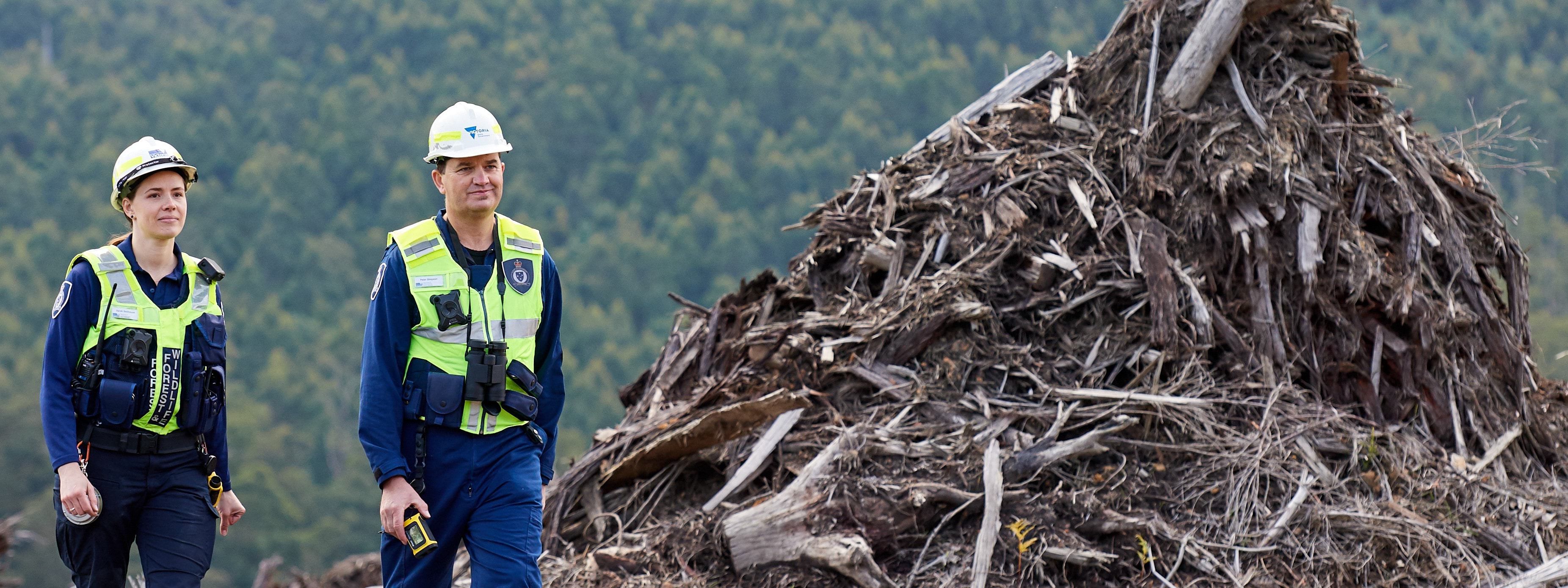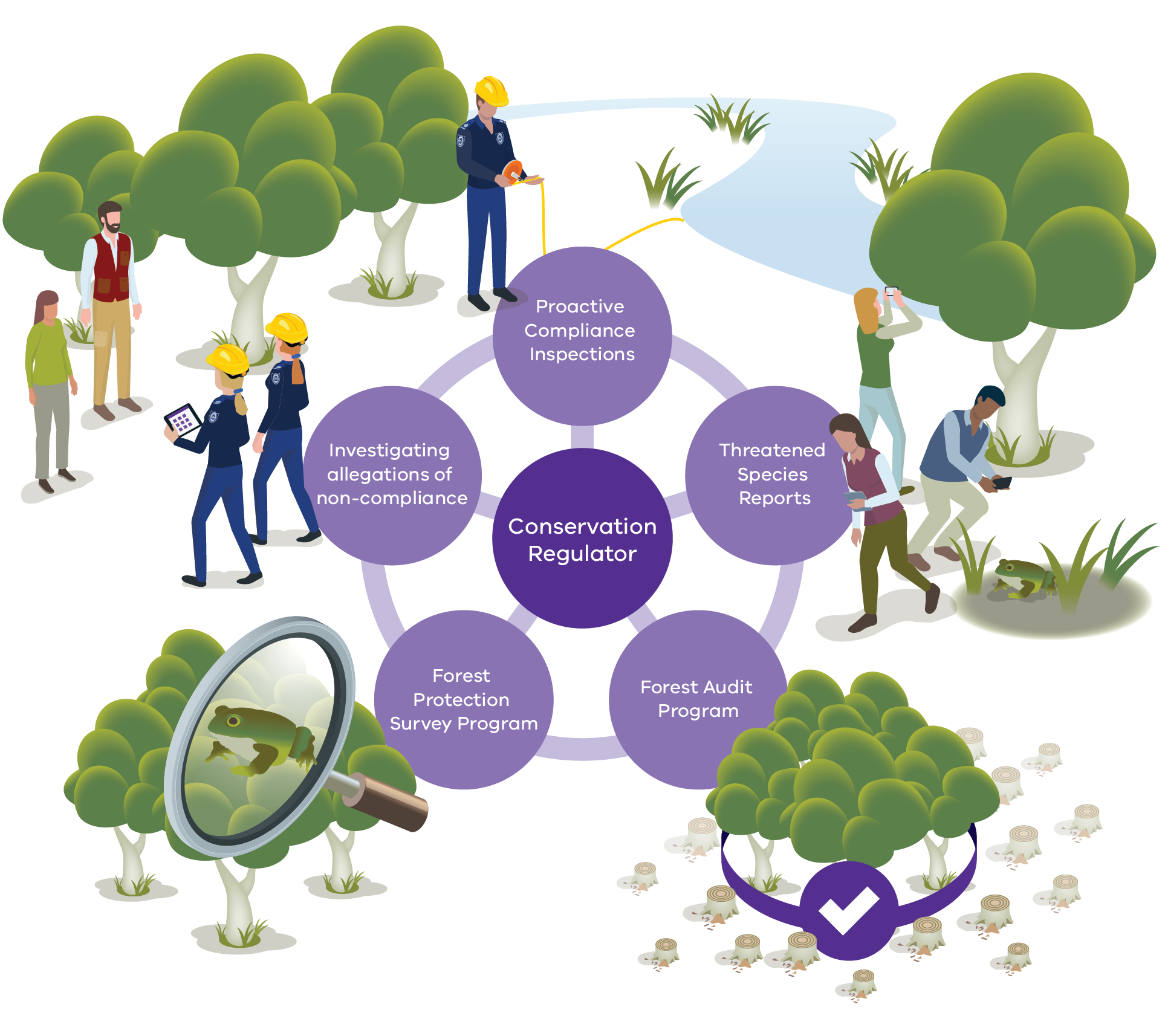Over the last 12 months, the Conservation Regulator remained focused on overseeing the compliance and enforcement of timber harvesting operations in state forests, even as the overall volume of harvesting was significantly lower than in previous years due to civil litigation and other factors.
A holistic approach to timber harvesting regulation
On 23 May 2023, the Victorian Government announced native timber harvesting will cease on 1 January 2024. Since the announcement, the Conservation Regulator has continued to regulate the industry focusing on harm prevention and biodiversity protection. This focus will continue as the industry transitions.
Figure 4 summarises how the Conservation Regulator works to ensure that the planning and conduct of timber harvesting operations comply with the law, and that important forest values are protected. In 2022-23, we continued to focus our regulatory effort on areas with potential for the greatest environmental harm and dedicate resources to reviewing and improving our processes. Approach to timber harvesting regulation
Proactive coupe inspections
The Conservation Regulator’s proactive Coupe Inspection Program focuses on preventing breaches of the law during timber harvesting, and identifying potential non-compliance post-harvest. Authorised Officers attend timber harvesting coupes to ensure compliance with a variety of priority areas, including waterway crossings, retained vegetation and exclusion zones, and coupe infrastructure, such as roading.
With a commitment to inspect 30 coupes each year, the Conservation Regulator delivered 56 proactive timber harvesting coupe inspections across Victoria during 2022–23, scrutinising duty-holder behaviour and delivering on improved compliance outcomes.
The Conservation Regulator has also actively engaged with community and duty-holders to explore areas where regulatory requirements are not well understood, and new guidance can be developed to improve compliance and environmental outcomes.
Reports of non-compliance and threatened species detections
The Conservation Regulator encourages members of the public to submit reports of alleged non-compliant timber harvesting activities, and the detection of threatened species or forest values found in or adjacent to planned timber harvesting locations. Assessing these reports is a priority for the Conservation Regulator and is undertaken by experienced Authorised Officers.
In 2022–23, we received and assessed 78 threatened species reports. We processed and closed 37 threatened species reports (including reports made in the previous financial year), and 74 of these reports remain under assessment. Several threatened species reports contain information about greater glider and yellow-bellied glider detections and have resulted in protections from timber harvesting where thresholds set in the relevant threatened species action statements are met. We received six reports of Leadbeater’s Possums in 2022–23, all of which resulted in the implementation of protection area that excludes timber harvesting around the detection.
Throughout the year we received and assessed 24 reports of alleged non-compliance and closed 25 reports (including some reported to the Conservation Regulator in previous financial years). 18 reports of alleged non-compliance remain under assessment.
The Conservation Regulator has also engaged with other agencies such as the Environment Protection Authority Victoria (EPA), WorkSafe, and Melbourne Water to drive an increased regulatory presence, and improve compliance capabilities and attitudes. Working with our valued partners from the EPA led to one Waste Abatement Notice being issued by Conservation Regulator Authorised Officers under the Environment Protection Act 2017 in 2022–23, resulting in the removal from state forest of contaminated soil posing risks to the environment and human health. Throughout the year Authorised Officers also engaged with duty-holders present at timber harvesting coupes to educate them about their new obligations under the Environment Protection Act 2017 where it related to their undertaking of timber harvesting operations, including the appropriate management of hydrocarbons (oil and petroleum products) relating to their harvesting machinery.
The Conservation Regulator issued five directions under section 70 of the Sustainable Forests (Timber) Act 2004. Section 70 direction notices allow the Conservation Regulator to require timber harvesting operators and duty-holders to take action to address non-compliance, prevent harm or remediate issues where these occur.
One of these directions was issued to prevent timber harvesting from occurring within in the Lerderderg State Forest, protected by a Special Protection Zone, prompted by information received from the community. This direction protected important forest and heritage values present in this area.
Five exciting years of biodiversity discovery and protection
In June 2023, we marked five years of the Forest Protection Survey Program and celebrated the program’s work and outcomes, including completion of 3,920 surveys within 1,784 coupes, and recording of 85,000 observations of plant and animal species in Victorian forests.
15,500 of those observations are of threatened species, including 744 observations of Leadbeater’s Possums which resulted in 4,900 hectares of forest specially protected as habitat. The Forest Protection Survey Program has also made an impact beyond timber harvesting through its significant contribution to the knowledge of species ranges and habitat, and the exciting identification of new species in Victoria. Some highlight finds are:
- Four new species of freshwater crayfish and one of Viola.
- New populations of Mt Cole and Colquhuon Grevilleas.
- The first record of a Pomaderris viridis in East Gippsland.
- An extended home range for the endangered long‑footed potoroo in the High Country.
Almost 330 giant burrowing frog tadpoles; a vulnerable species thought to be lost in the 2019‑20 bushfires.
The program has developed sophisticated procurement and data management systems, not only to better protect threatened species but also to support broader biodiversity conservation. Many of the program’s systems and processes support other parts of DEECA, such as threatened species risk assessments, post-fire assessments, and habitat distribution modelling.
Survey program data available at Forest Information Portal.(opens in a new window)
Forest Protection Survey Program
The Forest Protection Survey Program (FPSP) continued to conduct preharvest surveys to identify threatened or high-value biodiversity species in areas of state forests scheduled to be harvested. The surveys help record observations of target species that are required to be protected by VicForests.
Court results in early 2023 impacted VicForests operations resulting in a significant reduction to timber harvesting activities in the state’s east.
Consequently, the FPSP adapted to include surveying coupes scheduled for harvest in the state’s west and delivered more than 370 surveys that recorded approximately 18,500 observations, of which 2,000 are target species and values requiring legal protection.
Forest Audit Program
The Conservation Regulator delivered the Forest Audit Program (FAP) for the fourth year, maintaining an ongoing commitment to independently review timber harvesting operations using an annual, risk‑based approach.
The program measures compliance of commercial timber harvesting operations by auditing a representative sample of coupes harvesting in the 2022–23 financial year to assess a range of target themes, including:
- Protection of soil, water, and biodiversity values.
- Execution of in-coupe road design and construction.
- Implementation of forest coupe planning.
The 2022 Forest Audit Program inspected 32 coupes. Duty‑holder compliance has demonstrated a trend of improvement across the last three years. The mean compliance score of 96 per cent, above the 6-year average of 91 per cent. The Conservation Regulator is confident that improvements in compliance can, in part, be attributed to greater regulatory presence in timber harvesting.
Victorian Auditor General’s Office report – Regulating Victoria’s Native Forests
In October 2022, the Victorian Auditor General’s Office (VAGO) published its report Regulating Victoria’s Native Forests, which focused on the Conservation Regulator’s approach to responding to community reports submitted via the Forest Reports portal.
The VAGO report made a range of findings about the Conservation Regulator’s approach to regulation and acknowledged the significant progress made since the Regulator’s inception. The report outlined 10 recommendations for improvement, and DEECA subsequently approved or approved-in-principle all the recommendations.
The Conservation Regulator has made significant progress in implementing the recommendations, with 80 per cent fully acquitted by the end of 2022–23. (see Appendix A for details of each recommendation).
Statement of Regulatory Intent for Timber Harvesting Regulation
In 2019, the Conservation Regulator released its Statement of Regulatory Intent for Timber Harvesting Regulation and committed to publicly reporting on an annual basis on the performance measures it contained.
| Table 3: Performance measure results for timber harvesting compliance | Target | Result | Comment | |
|---|---|---|---|---|
| Per cent of coupes planned for timber harvesting that have been assessed in the Forest Protection Survey Program for the potential presence of target flora and fauna | 100% | 100% | Target met | |
| Per cent of coupes planned for timber harvesting that are field surveyed under the Forest Protection Survey Program with the potential presence of target flora and fauna | 64% | 64% | Target met | |
| Acknowledge receipt of reports of non-compliance | Workdays | <2 | 1.43 | Target met |
| Commence the verification of threatened species reports workdays | Workdays | <5 | 1.16 | Target met |
| Number of coupes harvested in previous year that were audited as part of the Forest Audit Program | 30 | 32 | Target met | |
| Number of coupes in which timber harvesting is underway or completed, that are subject to compliance inspection (includes spot checks for rainforest) | 30 | 56 | Target met | |
| Average time taken to investigate alleged or suspected non‑compliance | Months | <12 | 8 | Target met |
| Table 4: Activity measure | Result |
|---|---|
| Threatened species reports received | 78 |
Threatened species reports that underwent verification (The Conservation Regulator verifies threatened species reports where there is a relevant management action in the Code of Practice for Timber Production 2014, and where there is sufficient information in the report to enable verification) | 6 |
| Reports of alleged or suspected non‑compliance received | 24 |
| Reports of alleged or suspected non‑compliance investigated | 4 |
Updated


